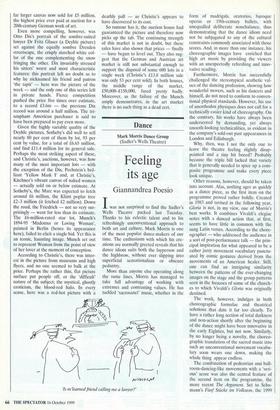Salerooms
Not so hot
Susan Moore
Hot. Red-hot. That seemed to be the universal verdict on the market for Ger- man and Austrian art prior to last week's bumper round of sales in London. Given the heat, perhaps it was inevitable that someone would get their fingers burned.
German and Austrian art has been one of the great saleroom success stories of recent years. Less than a decade ago, this was more or less exclusively a provincial market serving Germans, Austrians and Swiss. In 1993, after realising that German Expressionists consistently fetched far more in Impressionist and Modern Art sales in New York or London than they did on the Continent, Christie's tested the water with a specialist sale in London.
Given the quantity and quality of materi- al remaining in private hands, and the dearth, and expense, of good French pic- tures, they believed they had the makings of a vigorous new international market. No one, it seems, not even at Christie's, antici- pated the full potential of the market.
Christie's 1994 sale, the first in its pre- sent form, notched up six new auction records and a £7.7 million total. Three years later, the crop topped £32 million — an impressive £18 million even without the rare Klimt landscape which fetched the fabulous price of £14.5 million. The muse- um-quality pictures and the records contin- ued; so did the price rises and the contingent of international buyers (last week's sale had buyers from 12 countries). The significant change of last week, howev- er, was that for the first time Sotheby's joined in the fray, offering three competing sales the day before Christie's auction.
Previously, the Bond Street house had continued to field German and Austrian art in or alongside its Impressionist and Modern Art sales. For its first October foray, Sotheby's brought together over 300 works, including the major part of the Ger- man art amassed by music mogul Rolf Dcyhle, and material from the estate of the Wiener WerIcstatte fashion designer Emilie FlOge. In pride of place was Franz Marc's monumental 'The Waterfall' of 1912, a quintessential Blaue Reiter picture that had been de-accessioned by the Guggen- heim and sold at Sotheby's New York to the present vendor in 1974 for £45,000. At Christie's last October another Marc with a Guggenheim provenance tripled expecta- tions to sell for a record £3.3 million. This far larger canvas now sold for £5 million, the highest price ever paid at auction for a 20th-century German work of art.
Even more compelling, however, was Otto Dix's portrait of the sombre-suited lawyer Dr Fritz Glaser (a Deyhle picture) set against the equally sombre Dresden streetscape, the crisply starched white col- lar of the one complementing the snow fringing the other. Dix invariably stressed his sitters' worst and most characteristic features: this portrait left no doubt as to why he nicknamed his friend and patron 'the tapir' — here was the picture of the week — and the only one of this series left in private hands. Fierce competition pushed the price five times over estimate, to a record £3.6m — the previous Dix record was around a half million. The tri- umphant American purchaser is said to have been prepared to pay even more.
Given the highly variable quality of the Deyhle pictures, Sotheby's did well to sell nearly 80 per cent of them by lot, 93 per cent by value, for a total of £6.65 million, and find £11.4 million for its general sale. Perhaps the most striking aspect of these, and Christie's, auctions, however, was how many of the most important lots — with the exception of the Dix, Pechstein's bril- liant 'Yellow Mask I' and, at Christie's, Kirchner's vibrant canvas of naked women — actually sold on or below estimate. At Sotheby's, the Marc was expected to fetch around £6 million, the Klimt poplar tree £2-3 million (it fetched £2 million). Down the road, the Friedrich — not so very sur- prisingly — went for less than its estimate. The £6-million-rated star lot, Munch's 1894-95 'Madonna or Loving Woman', painted in Berlin (hence its appearance here), failed to elicit a single bid. Yet this is an iconic, haunting image. Munch set out to represent Woman from the point of view of her lover at the moment of conception.
According to Christie's, there was inter- est in the picture from museums and high flyers, and no one seemed to balk at the price. Perhaps the rather thin, flat picture surface put people off, or the 'difficult' nature of the subject; the mystical, ghostly eroticism, the blood-red halo. In every sense, here was a red-hot picture with a deathly pall — as Christie's appears to have discovered to its cost.
So rumour has it, the auction house had guaranteed the picture and therefore now picks up the tab. The continuing strength of this market is not in doubt, but these sales have also shown that prices — finally — have begun to level out. They also sug- gest that the German and Austrian art market is still not substantial enough to support the disposal of some 600 lots in a single week (Christie's £13.8 million sale was only 53 per cent sold). In both houses, the middle range of the market, £50,000–£150,000, fared pretty badly. Moreover, as the failure of the Munch amply demonstrates„ in the art market there is no such thing as a dead cert.



















































































 Previous page
Previous page